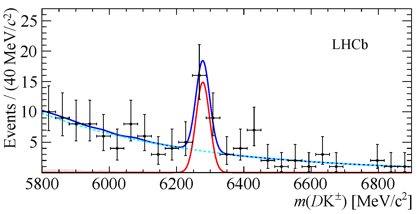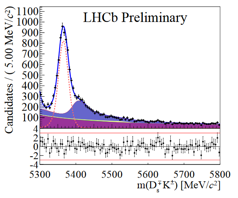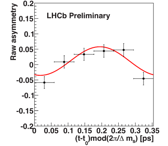The LHCb collaboration presented several new results at the 9th International Workshop on the CKM Unitarity Triangle (CKM2016) taking place this week at the Tata Institute of Fundamental Research in Mumbai, India. A few selected items are listed below.
(1) A surprising first observation of a decay of the charm beauty meson. LHCb searched for the decay of the Bc+ meson into charm D0 and strange K+ mesons and surprisingly found a signal. The Bc+ is the only meson consisting of two heavy quarks of different flavour, namely a b and a c quark. Unlike other B mesons, the b quark decay accounts only for a small fraction of Bc+ decays, with the c quark decay accounting for the majority of them. The image shows a clear enhancement around the Bc+ mass in the D0 and K meson invariant mass spectrum. The contribution of the Bc+→D0K+ decay, shown as the red Gaussian distribution, is observed with a statistical significance of 5.1σ. The result is surprising because the measured decay rate is high compared to theoretical predictions, and it was not yet thought that there were sufficient data collected to see a signal. It will be a nice challenge for theoretical physicists to understand the origin of this unexpected result. For experts: The so-called “tree-amplitude” decay Bc+→D0π+ is not yet observed. The Bc+→D0K+ decay proceeds predominantly through penguin and annihilation decay diagrams. This is the first observation of a Bc+ decay dependent on such processes.
(2) CP violation and γ angle measurements in Bs→DsK decays. The image shows the DsK invariant mass distribution for different charge combinations of Ds and K mesons. The Bs meson contribution is shown as the dashed red line while the other shaded areas represent different background components. A detailed analysis allowed LHCb physicists to extract a value of the Cabibbo-Kobayashi-Maskawa (CKM) angle γ (see introduction in the 5 October 2012 news). The Bs→DsK decay proceeds via so-called “tree-level” diagrams, in which contributions of new physics are not expected. Together with other “tree-level” γ angle measurements (see item (1) in the 13 March 2016 news) it provides a powerful consistency check of the Standard Model and establishes reference measurements which could then be compared with the γ angle determination from other processes in which signs of new physics effects could show up.
(3) First observation of CP violation in Bs→K+K– decays. The measurement of CP violation in the charmless two body decays B0→π+π– and Bs→K+K– was presented. The word “charmless” indicates the fact that there are no particles containing a charm quark in the decay products. CP violation in Bs→K+K– decays has been observed for the first time. The CP-violating asymmetries were measured as a function of the beauty meson decay time, as shown in the image. As apparent in the figure, the characteristic fast Bs meson oscillation pattern is observed.
(4) Study of the γ angle from B–→D0K*- decays. The potential for the measurement of the γ angle and of various CP violation measurements in B–→D0K*- meson decays was presented. In this measurement the D0 meson decays into various pairs of charged π and K mesons. B–→D0K– decays have been extensively analysed in the past but the B–→D0K*- mode is studied at LHCb for the first time. The analysis has demonstrated that high purity is possible in this decay mode at LHCb owing to the absence of any significant physics backgrounds, as shown in the image. While in items (1), (2) and (3) the analyses used the full 3fb-1 LHC run 1 data sample, this analysis profited from an additional 1fb-1 collected during run 2 data taking period. The significant increase in signal yield per unit of integrated luminosity in run 2 (see 5 August 2016 news, item (1)) bodes well for improvements in the knowledge of γ in future analyses at LHCb.
See more details in the LHCb CKM workshop presentations linked from the section titles in italic and soon in the LHCb papers and conference notes. Click on the images for higher resolution.




